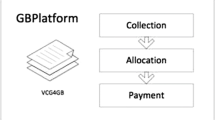Abstract
Group-buying auction is a new business model in e-commerce. This auction has its own characteristics that make it distinct from other types of auctions. Customers' waiting time is an inherent attribute for group-buying auction. However, this attribute is rarely considered in the previous pricing models. Therefore, finding an appropriate pricing model for it seems to be of great importance. In this paper, with the help of game-theory concepts and according to each customer's waiting time in group-buying auction, a pricing model for a duopolistic market is proposed which takes into account both customers' and sellers' satisfaction. The pricing model shows that customers' awareness of Internet group-buying auction is so important and if it is lower than a boundary value, then the group-buying seller could not compete in the market. The model emphasizes on economies of scale as a significant factor in the success of the auction. The model also stresses the importance of gaining customers with lower product value in the group-buying auction.


Similar content being viewed by others
Notes
The P 1 + B.T g amount is the maximum amount of P 1 + B.T w for all customers. Considering this boundary amount, we can be assured of the purchasing of all the customers, even if the group-buying auction fails to reach to the second price
Pricing models have implemented with MATLAB. Numerical examples are also added to appendix section, which is available from the authors.
References
Anand, S. K., & Aron, R. (2003). Group-buying on the web: a comparison of price discovery mechanisms. Management Science, 48(11), 1546–562.
Ancarani, F. (2002). Pricing and the Internet: frictionless commerce or pricer's paradise? European Management Journal, 20(6), 680–687.
Breidert, C. (2006). Estimation of willingness-to-pay theory, measurement, application. New Mexico: Springer.
Chen, J., Chen, X., & Song, X. (2007). Comparison of the group-buying auction and the fixed pricing mechanism. Decision Support Systems, 43, 445–459.
Chen, J., Chen, X., Kauffman, R. J., & Song, X. (2009). Should we collude? Analyzing the benefits of bidder cooperation in online group-buying auctions. Electronic Commerce Research and Applications, 8(4), 191–202.
Chen, J., Kauffman, R. J., Liu, Y., & Song, X. (2010). Segmenting uncertain demand in group-buying auctions. Electronic Commerce Research and Applications, 9(2), 126–147.
Chun, S. H., & Kim, J. C. (2005). Pricing strategies in B2C electronic commerce: analytical and empirical approaches. Decision Support Systems, 40, 375–388.
Dube, P., Liu, Z., Wynter, L., & Xia, C. (2007). Competitive equilibrium in e-commerce: pricing and outsourcing. Computers & Operations Research, 34, 3541–3559.
Garbarino, E., & Maxwell, S. (2010). Consumer response to norm-breaking pricing events in e-commerce. Journal of Business Research, 63, 1066–1072.
Hotelling, H. (1929). Stability in competition. Economic Journal, 39(153), 41–57.
Kauffman, R. J., & Wang, B. (2002). New buyers' arrival under dynamic pricing market microstructure: the case of group-buying discounts on the Internet. Journal of Management Information Systems, 18, 157–188.
Kauffman, R. J., Lai, H., & Ho, C. T. (2010a). Incentive mechanisms, fairness and participation in online group-buying auctions. Electronic Commerce Research and Applications, 9(3), 249–262.
Kauffman, R. J., Lai, H., & Lin, H.-C. (2010b). Consumer adoption of group-buying auctions: an experimental study. Information Technology and Management, 11(4), 191–211.
Kopalle, P., Biswas, D., Chintagunta, P. K., Fan, J., Pauwels, K., Ratchford, B. T., et al. (2009). Retailer pricing and competitive effects. Journal of Retailing, 85(1), 56–70.
Lai, C. H., & Zhuang, T. Y. (2004). Comparing the performance of group-buying models with different incentive mechanisms. the Third Workshop on e- Business,. Washington, DC.
Lee, S., Illia, A., & Lawson-Body, A. (2011). Perceived price fairness of dynamic pricing. Industrial Management & Data Systems, 111(4), 531–550.
Li, B., & Tang, F. F. (2011). Online pricing dynamics in Internet retailing: the case of the DVD market. Electronic Commerce Research and Applications, 10, 227–236.
Li, Y. M., Jhang-Li, J. H., Hwang, T. K., & Chen, P. W. (2010). Analysis of pricing strategies for community-based group buying: the impact of competition and waiting cost. Information Systems Frontiers, 10, 1–13.
Nagle, T., & Holden, R. (2002). Strategy and tactics of pricing (3rd ed.). New Jersey: Prentice-Hall.
Author information
Authors and Affiliations
Corresponding author
Rights and permissions
About this article
Cite this article
Sharif Vaghefi, M., Sharif Vaghefi, M. & Beheshti, N. A pricing model for group-buying auction based on customers' waiting-time. Mark Lett 25, 425–434 (2014). https://doi.org/10.1007/s11002-013-9262-1
Published:
Issue Date:
DOI: https://doi.org/10.1007/s11002-013-9262-1




